#otd in Royal History 16 - 30 November
- LSS
- Nov 17, 2022
- 35 min read
Updated: Nov 15, 2024
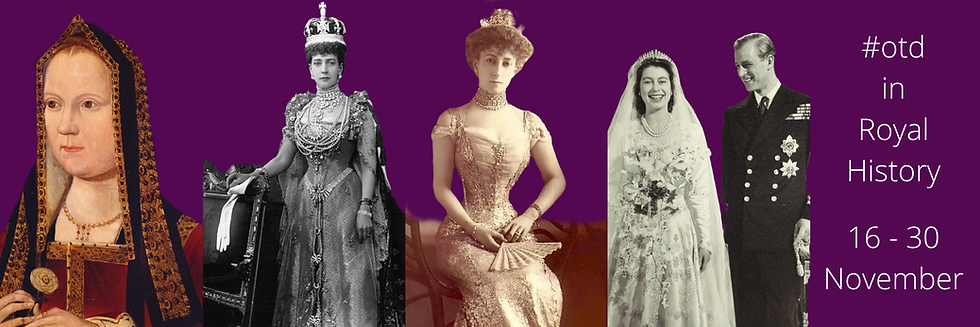
16 November

16 November 1093
Saint Margaret of Scotland died
Saint Margaret of Scotland, also known as Margaret of Wessex, was an English princess & a Scottish queen. Margaret was sometimes called "The Pearl of Scotland". She was born in the Kingdom of Hungary around 1045 to the expatriate English prince Edward the Exile, Margaret & her family returned to England in 1057. Following the death of king Harold II at the Battle of Hastings in 1066, her brother Edgar Ætheling was elected as King of England but never crowned. After she & her family fled north, Margaret married Malcolm III of Scotland by the end of 1070.
Margaret was a very pious Christian, & among many charitable works she established a ferry across the Firth of Forth in Scotland for pilgrims travelling to St Andrews in Fife, which gave the towns of South Queensferry & North Queensferry their names. Margaret was the mother of three kings of Scotland, or four, if Edmund of Scotland (who ruled with his uncle, Donald III) is counted, & of a queen consort of England. According to the Vita S. Margaritae (Scotorum) Reginae (Life of St. Margaret, Queen (of the Scots)), attributed to Turgot of Durham, Margaret died at Edinburgh Castle in Edinburgh, Scotland in 1093, merely days after receiving the news of her husband's death at The Battle of Alnwick
Pope Innocent IV canonized her in 1250, & her remains were reinterred in a shrine in Dunfermline Abbey in Fife, Scotland. Her relics were dispersed after the Scottish Reformation & lost. Mary, Queen of Scots, at one time owned her head, which was preserved by Jesuits in the Scots College, Douai, France, from where it was subsequently lost during the French Revolution.
Malcolm & Margaret had eight children, six sons & two daughters:
Edward, killed 1093
Edmund of Scotland
Ethelred, abbot of Dunkeld
King Edgar of Scotland
King Alexander I of Scotland
Matilda of Scotland, married Henry I of England
Mary of Scotland, married Eustace III of Boulogne
King David I of Scotland
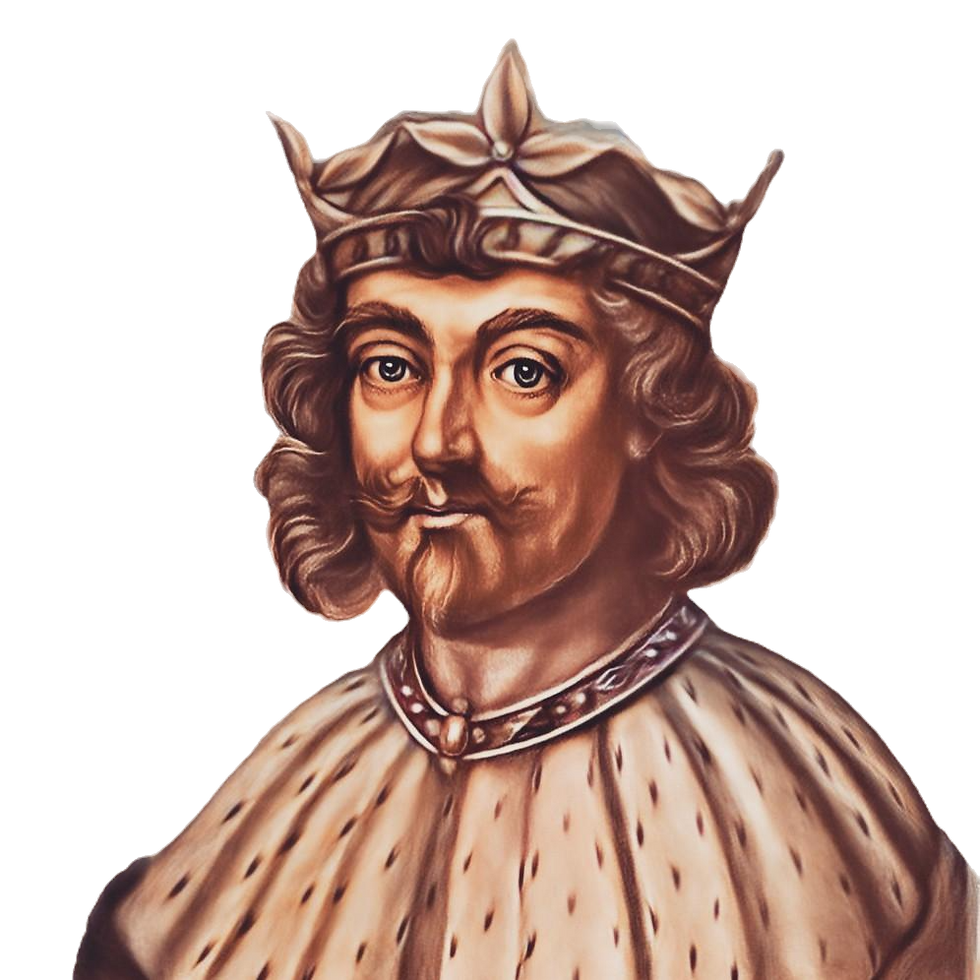
16 November 1272
Henry III, king of England died
In 1270, Henry became increasingly ill; concerns about a fresh rebellion grew & the next year the King wrote to his son asking him to return to England, but Edward did not turn back. Henry recovered slightly & announced his renewed intention to join the crusades himself, but he never regained his full health & on the evening of 16 November 1272 Henry died in Westminster aged 65, probably with Queen Eleanor in attendance. He was succeeded by Edward I who slowly made his way back to England via Gascony, finally arriving in August 1274.
At his request, Henry was buried in Westminster Abbey in front of the church's high altar, in the former resting place of Edward the Confessor. A few years later, work began on a grander tomb for the King & in 1290 Edward moved his father's body to its current location in Westminster Abbey. His gilt-brass funeral effigy was designed & forged within the abbey grounds by William Torell; unlike other effigies of the period, it is particularly naturalistic in style, but it is probably not a close likeness of Henry himself.
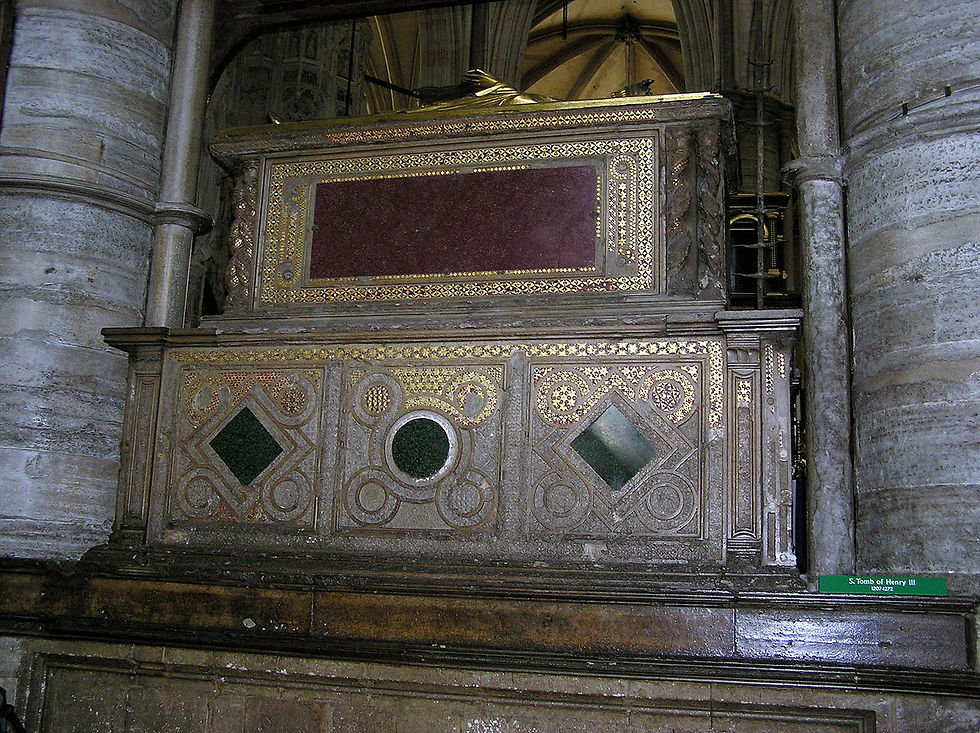
Henry's final tomb resembled the shrine of a saint, complete with niches possibly intended to hold relics. When the King's body was exhumed in 1290, contemporaries noted that the body was in perfect condition & that Henry's long beard remained well preserved, which at the time was considered to be an indication of saintly purity. Miracles began to be reported at the tomb, but Edward was sceptical about these stories. The reports ceased, & Henry was never canonised. In 1292 Henry's heart was removed from his tomb & reburied at Fontevraud Abbey with the bodies of his Angevin family.
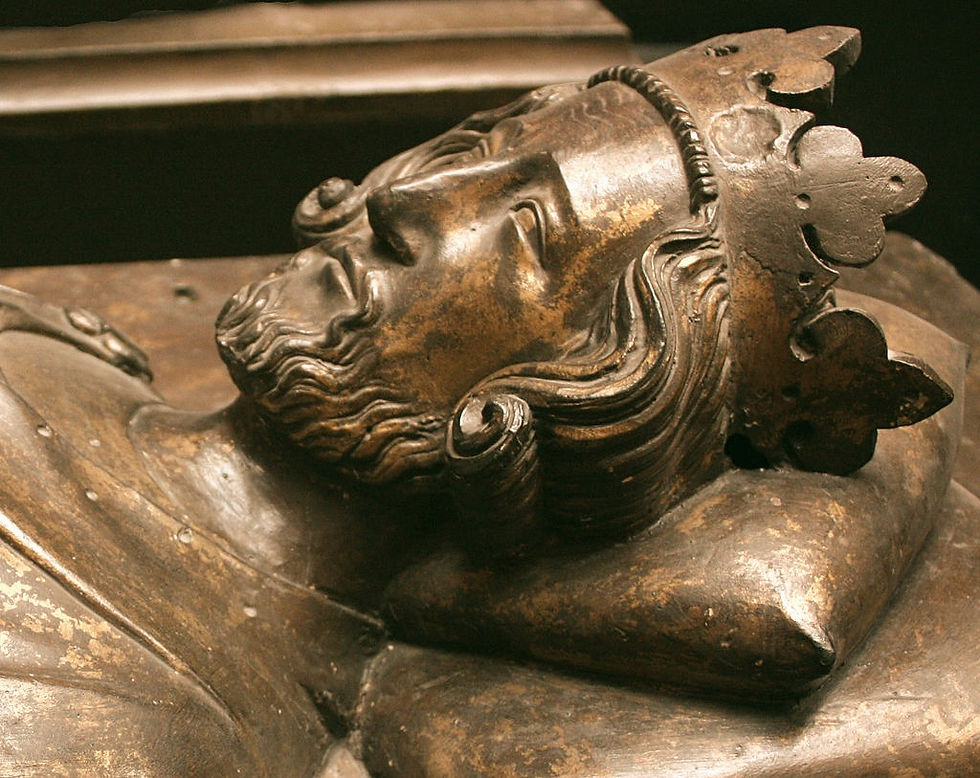
Henry III (born. 1 October 1207 – died. 16 November 1272)
Coronation: 28 October 1216, Gloucester Cathedral.
Henry was King of England, Lord of Ireland, & Duke of Aquitaine from 1216 until his death.
He was the fourth king of the House of Plantagenet. The son of King John & Isabella of Angoulême, Henry assumed the throne when he was only nine in the middle of the First Barons' War. Cardinal Guala declared the war against the rebel barons to be a religious crusade & Henry's forces, led by William Marshal, defeated the rebels at the battles of Lincoln & Sandwich in 1217.
Henry promised to abide by the Great Charter of 1225, which limited royal power & protected the rights of the major barons. In 1230, the King attempted to reconquer the provinces of France that had once belonged to his father, but the invasion was a debacle. A revolt led by William Marshal's son, Richard Marshal, broke out in 1232, ending in a peace settlement negotiated by the Church.
Following the revolt, Henry ruled England personally, rather than governing through senior ministers. He travelled less than previous monarchs, investing heavily in a handful of his favourite palaces & castles. Henry was known for his piety, holding lavish religious ceremonies & giving generously to charities; the King was particularly devoted to the figure of Edward the Confessor, whom he adopted as his patron saint. He extracted huge sums of money from the Jews in England, ultimately crippling their ability to do business, & as attitudes towards the Jews hardened, he introduced the Statute of Jewry, attempting to segregate the community.

In a fresh attempt to reclaim his family's lands in France, he invaded Poitou in 1242, leading to the disastrous Battle of Taillebourg. After this, Henry relied on diplomacy, cultivating an alliance with Frederick II, Holy Roman Emperor. Henry supported his brother Richard of Cornwall in his bid to become King of the Romans in 1256 but was unable to place his own son Edmund Crouchback on the throne of Sicily, despite investing large amounts of money. Henry had planned to go on crusade to the Levant but was prevented from doing so by rebellions in Gascony.

By 1258, Henry's rule was increasingly unpopular, the result of the failure of his expensive foreign policies & the notoriety of his Poitevin half-brothers, the Lusignans, as well as the role of his local officials in collecting taxes & debts. A coalition of his barons, initially probably backed by Eleanor, seized power in a coup d'état & expelled the Poitevins from England, reforming the royal government through a process called the Provisions of Oxford. Henry & the baronial government enacted a peace with France in 1259, under which Henry gave up his rights to his other lands in France in return for King Louis IX recognising him as the rightful ruler of Gascony. The baronial regime collapsed but Henry was unable to reform a stable government & instability across England continued.
In 1263, one of the more radical barons, Simon de Montfort, seized power, resulting in the Second Barons' War. Henry persuaded Louis to support his cause & mobilised an army. The Battle of Lewes occurred in 1264, where Henry suffered defeat & was taken prisoner. Henry's eldest son, Edward, escaped from captivity to defeat de Montfort at the Battle of Evesham the following year & freed his father. Henry initially enacted a harsh revenge on the remaining rebels but was persuaded by the Church to mollify his policies through the Dictum of Kenilworth. Henry died in 1272. He was buried in Westminster Abbey, which he had rebuilt in the second half of his reign & was moved to his current tomb in 1290.
Henry married Eleanor of Provence (c. 1223 – 24/25 June 1291) in 1236. They had five children:
Edward I (b. 17/18 June 1239 – d. 7 July 1307).
Margaret (b. 29 September 1240 – d. 26 February 1275), she was Queen of Scots by marriage to King Alexander III.
Beatrice (b. 25 June 1242 – d. 24 March 1275).
Edmund 'Crouchback' (16 January 1245 – d. 5 June 1296).
Katherine (b. 25 November 1253 – d. 3 May 1257).
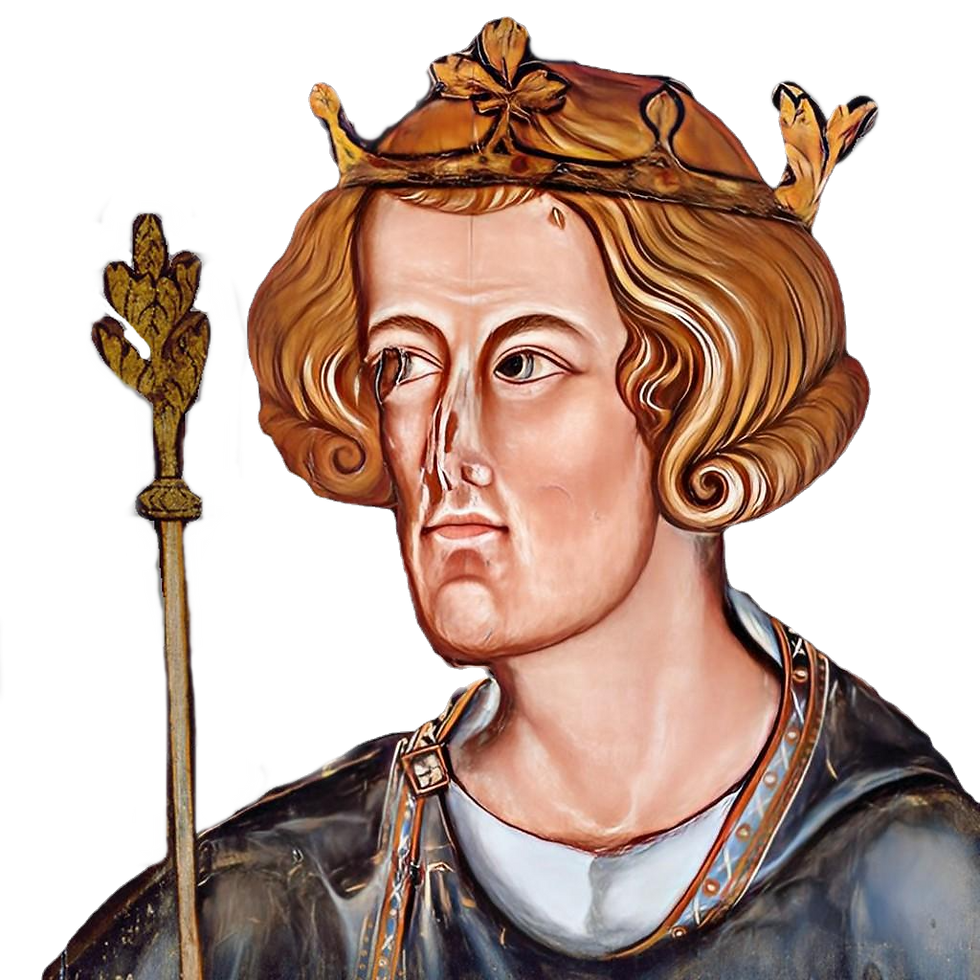
16 November 1272
While travelling during the Ninth Crusade, Prince Edward becomes King of England upon Henry III of England's death, but he will not return to England for nearly two years to assume the throne.
17 November
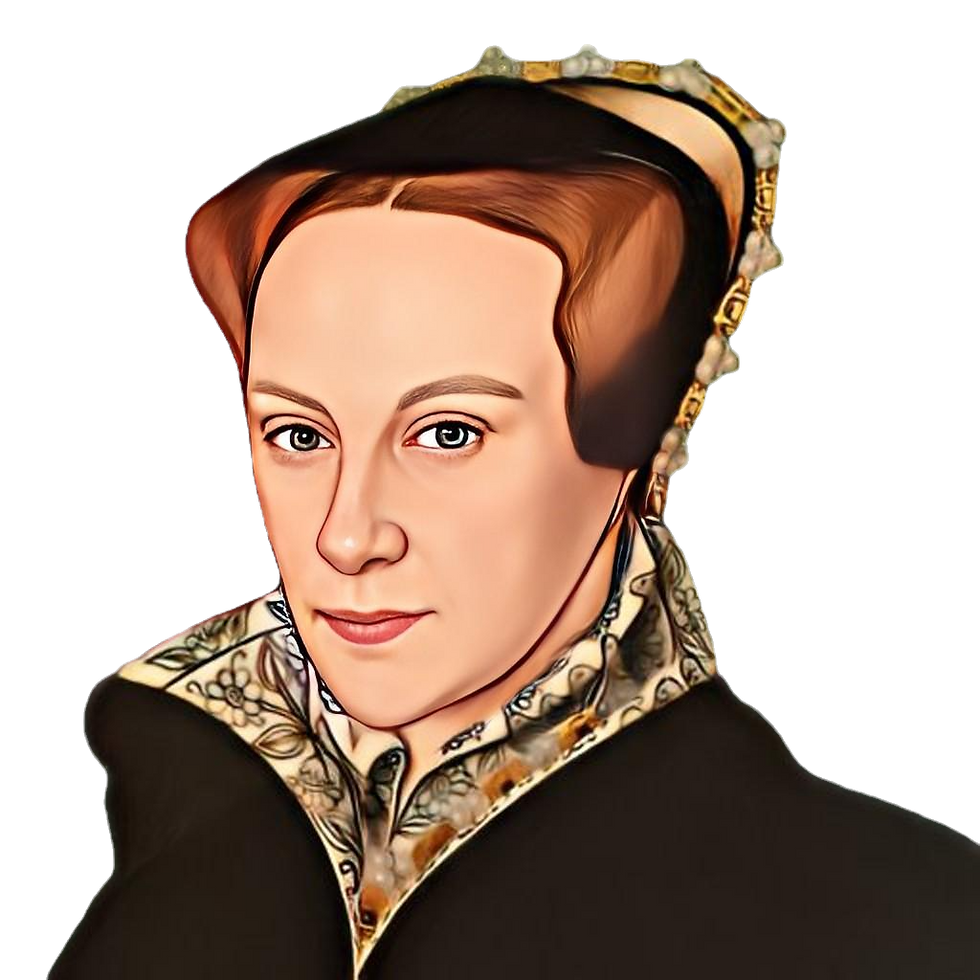
17 November 1558
Mary I of England died
Mary I (reigned. July 1553 – 17 November 1558)
Born. 18 February 1516
Coronation: 1 October 1553.
Also known as Mary Tudor, was the queen of England & Ireland from July 1553 until her death. She is best known for her vigorous attempt to reverse the English Reformation, which had begun during the reign of her father, Henry VIII. Her attempt to restore to the Church the property confiscated in the previous two reigns was largely thwarted by parliament, but during her five-year reign, Mary had over 280 religious dissenters burned at the stake in the Marian persecutions, which led to her denunciation as "Bloody Mary" by her Protestant opponents.
Mary was the only child of Henry VIII by his first wife, Katharine of Aragon, to survive to adulthood. Her younger half-brother Edward VI succeeded their father in 1547 at the age of nine. When Edward became mortally ill in 1553, he attempted to remove Mary from the line of succession because he supposed, correctly, that she would reverse the Protestant reforms that had begun during his reign. Upon his death, leading politicians proclaimed Lady Jane Grey as queen. Mary speedily assembled a force in East Anglia & deposed Jane, who was ultimately beheaded. Mary was—excluding the disputed reigns of Jane & the Empress Matilda—the first queen regnant of England. In 1554, Mary married Philip of Spain, becoming queen consort of Habsburg Spain on his accession in 1556.

After Mary's death in 1558, her re-establishment of Roman Catholicism was reversed by her younger half-sister & successor, Elizabeth I.

17 November 1818
Queen Charlotte died
The Queen died in the presence of her eldest son, the prince Regent (later King George IV), who was holding her hand as she sat in an armchair at the family's country retreat, Dutch House in Surrey (now known as Kew Palace). She was buried at St George's Chapel at Windsor Castle. Her husband died just over a year later. She is the second longest-serving consort in British history (after Prince Philip, Duke of Edinburgh), having served as such from her marriage (on 8 September 1761) to her death (17 November 1818), a total of 57 years & 70 days.
Her eldest son, the prince Regent, claimed Charlotte's jewels at her death, but the rest of her property was sold at auction from May to August 1819. Her clothes, furniture, & even her snuff was sold by Christie's. It is highly unlikely that her husband ever knew of her death. He died blind, deaf, lame & insane fourteen months later.

Queen Charlotte sat for Sir Thomas Lawrence in September 1789. His portrait of her was exhibited at the Royal Academy the following year. Reviewers thought it "a strong likeness".

Charlotte of Mecklenburg-Strelitz (Sophia Charlotte; 19 May 1744 – 17 November 1818) was Queen of Great Britain & Ireland as the wife of King George III from their marriage on 8 September 1761 until the union of the two kingdoms on 1 January 1801, after which she was Queen of the United Kingdom until her death in 1818. As George's wife, she was also Electress of Hanover until becoming Queen of Hanover on 12 October 1814, when the electorate became a kingdom.
'Sophia Charlotte' was born into the royal family of Mecklenburg-Strelitz, a duchy in northern Germany. In 1760 the young & unmarried George III inherited the British throne. George considered Charlotte a suitable consort, & they married in 1761. The marriage lasted 57 years & produced 15 children, 13 of whom survived to adulthood. They included two future British monarchs, George IV & William IV; as well as Charlotte, Princess Royal, who became Queen of Württemberg; Prince Edward, the father of Queen Victoria; Prince Adolphus, grandfather of the British queen consort Mary of Teck; & Prince Ernest Augustus, who became King of Hanover.
Charlotte was a patron of the arts & an amateur botanist who helped expand Kew Gardens. She maintained a close relationship with Queen Marie Antoinette of France, & the French Revolution likely enhanced the emotional strain felt by Charlotte. Her eldest son, George, was appointed as Prince Regent in 1811 due to the increasing severity of the King's mental illness. Charlotte died in 1818. Her husband, who was likely unaware of her death, died a little over a year later.

18 November

18 November 1851
Ernest Augustus, King of Hanover died
Ernest Augustus (born.5 June 1771) was King of Hanover from 20 June 1837 until his death. He was the fifth son & eighth child of George III, who eleven years before Ernest's birth had inherited the thrones of two kingdoms, Great Britain & Ireland, & also that of the Electorate of Hanover, still part of the Holy Roman Empire.
As a fifth son, Ernest seemed unlikely to become a monarch, but none of his four elder brothers produced a legitimate son who lived past infancy. The Salic Law, which barred succession "to or through a woman," prevailed in Hanover; therefore, when his elder brother William IV died in 1837, Ernest succeeded him as King of Hanover, for Hanover had become a 'Kingdom' when the Holy Roman Empire was abolished in 1806. In the United Kingdom, however, where a different law of succession prevailed, Queen Victoria succeeded to the throne, thus ending the personal union between the British Isles & Hanover that had existed since 1714.

Ernest was born in England but was sent to Hanover in his adolescence for his education & military training. While serving with Hanoverian forces in Wallonia against Revolutionary France, he received a disfiguring facial wound. In 1799, he was created Duke of Cumberland & Teviotdale.
He married Frederica of Mecklenburg-Strelitz (3 March 1778 – 29 June 1841). They had one child; George V (27 May 1819 – 12 June 1878), who was the last King of Hanover.

19 November
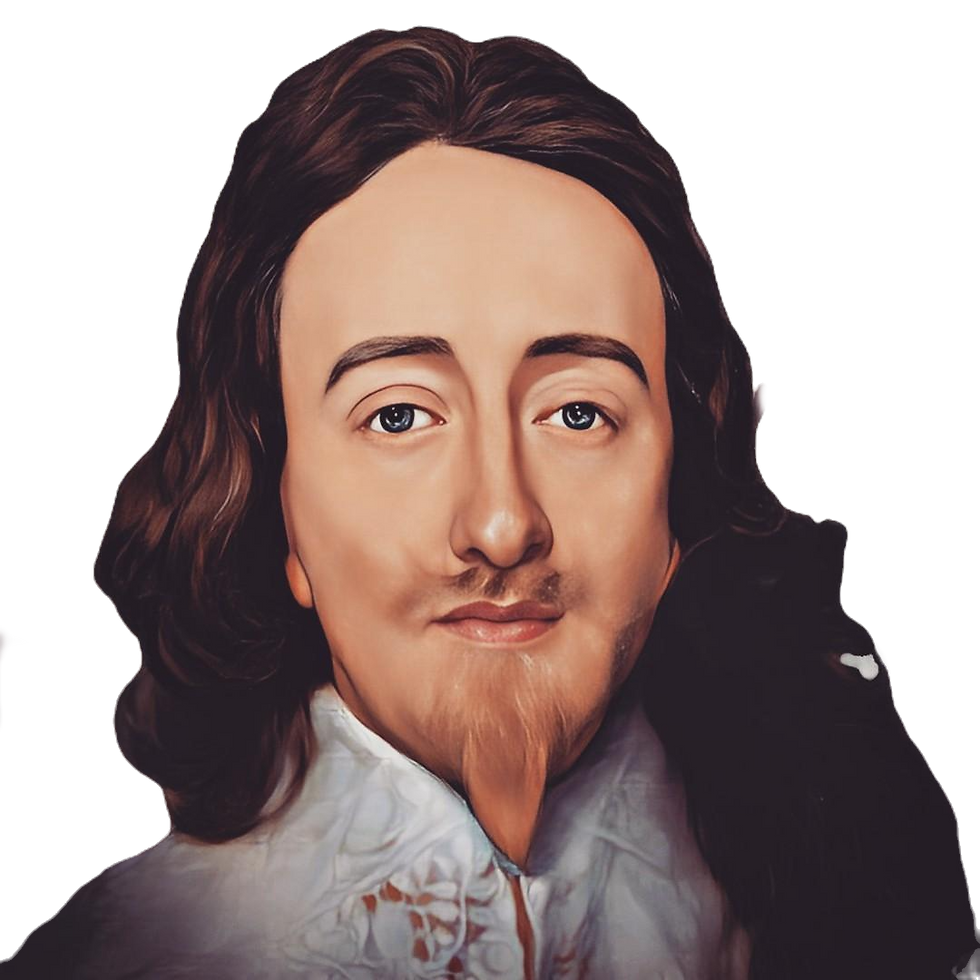
19 November 1600
Charles I was born
Charles was born in Dunfermline Palace, Fife, on 19 November 1600. Charles I was monarch of the three kingdoms of England, Scotland, & Ireland from 27 March 1625 until his execution in 1649.
Charles was the second son of King James VI of Scotland & Anne of Denmark. He was born in Dunfermline Palace, Fife, on 19 November 1600. At a Protestant ceremony in the Chapel Royal of Holyrood Palace in Edinburgh on 23 December 1600, he was baptised by David Lindsay, Bishop of Ross, & created Duke of Albany, the traditional title of the second son of the King of Scotland, with the subsidiary titles of Marquess of Ormond, Earl of Ross & Lord Ardmannoch.
20 November

A 12th-century depiction of Edmund's martyrdom in the Morgan Library & Museum in New York.
20 November 869
Edmund the Martyr died (b. 841)
Edmund the Martyr (also known as St Edmund or Edmund of East Anglia, died 20 November 869) was king of East Anglia from about 855 until his death. Edmund's cult flourished in the Early & High Middle Ages, & he & Edward the Confessor were regarded as England's patron saints until they were replaced by Saint George in the fifteenth century.
Unfortunately, almost nothing is known about Edmund. He is thought to have been of East Anglian origin & was first mentioned in an annal of the Anglo-Saxon Chronicle, written years after his death. The kingdom of East Anglia was invaded by the Vikings, who destroyed any contemporary evidence of his reign.
Hel-hama, CC BY-SA 3.0 <https://creativecommons.org/licenses/by-sa/3.0>, via Wikimedia Commons
In 869, the 'Great Heathen Army' advanced on East Anglia & killed Edmund. According to Asser & the Anglo-Saxon Chronicle, he died in battle, but by later tradition, he met his death at an unidentified place known as Haegelisdun, after he refused the Danes' demand that he renounce Christ: the Danes beat him, shot him with arrows & then beheaded him, on the orders of Ivar the Boneless & his brother Ubba. According to one legend, his head was then thrown into the forest, but was found by searchers following the cries of an ethereal wolf calling out in Latin, "Hic, Hic, Hic" – "Here, Here, Here".

A medieval illumination depicting the death of Edmund the Martyr on 20 November 869 by the Vikings.
A coinage commemorating Edmund was minted from around the time East Anglia was absorbed by the kingdom of Wessex & a popular cult emerged. In about 986, Abbo of Fleury wrote of his life & martyrdom. His remains were temporarily moved from Bury St Edmunds to London for safekeeping in 1010. His shrine at Bury was visited by many kings, including Canute, who was responsible for rebuilding the abbey: the stone church was rebuilt again in 1095. During the Middle Ages, when Edmund was regarded as the patron saint of England, Bury & its abbey grew wealthy, but during the Dissolution of the Monasteries his shrine was destroyed.
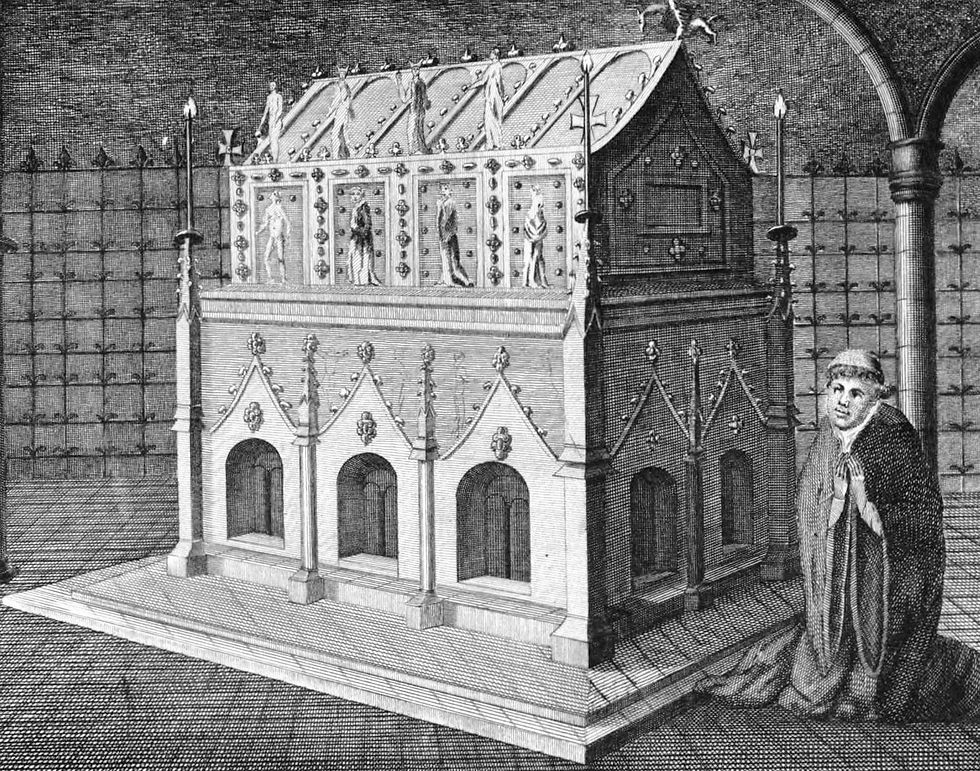

20 November 1925
Queen Alexandra died
Alexandra retained a youthful appearance into her senior years, but during the war (First World War) her age caught up with her. She took to wearing elaborate veils & heavy makeup, which was described by gossips as having her face "enamelled". She made no more trips abroad & suffered increasing ill health. In 1920, a blood vessel in her eye burst, leaving her with temporary partial blindness. Towards the end of her life, her memory & speech became impaired.
She died on 20 November 1925 at Sandringham after suffering a heart attack & was buried in an elaborate tomb next to her husband king Edward VII in St George's Chapel, Windsor Castle.

Alexandra of Denmark (1 December 1844 – 20 November 1925) was Queen of the United Kingdom & the British Dominions & Empress of India from 22 January 1901 to 6 May 1910 as the wife of King-Emperor Edward VII.
Alexandra's family had been relatively obscure until 1852, when her father, Prince Christian of Schleswig-Holstein-Sonderburg-Glücksburg, was chosen with the consent of the major European powers to succeed his second cousin Frederick VII as king of Denmark. At the age of sixteen Alexandra was chosen as the future wife of Albert Edward, Prince of Wales, the heir apparent of Queen Victoria. The couple married in 1863, the year in which her father became king of Denmark as Christian IX & her brother was appointed king of Greece as George I. She was Princess of Wales from 1863 to 1901, the longest anyone has ever held that title, & became generally popular; her style of dress & bearing were copied by fashion-conscious women. Largely excluded from wielding any political power, she unsuccessfully attempted to sway the opinion of British ministers & her husband's family to favour Greek & Danish interests. Her public duties were restricted to uncontroversial involvement in charitable work.
On the death of Queen Victoria in 1901, Albert Edward became king-emperor as Edward VII, with Alexandra as queen-empress. She held the status until Edward's death in 1910. She greatly distrusted her nephew Wilhelm II, German Emperor, & supported her son George V during the First World War, in which Britain & its allies fought Germany.
For more about Queen Alexandra visit here.

20 November 1938
Maud of Wales, Queen of Norway died
Maud was born on 26 November 1869 at Marlborough House, London. She was the third daughter & fifth child of Albert Edward, Prince of Wales (later king Edward VII), the eldest son of Queen Victoria, & Alexandra, Princess of Wales, the eldest daughter of King Christian IX of Denmark. She was Queen of Norway as the wife of King Haakon VII.
In October 1938 Maud came to England for a visit. Initially she stayed at Sandringham, but then moved into a hotel in London's West End. She became ill & was taken to a nursing home, where an abdominal operation was performed on 16 November 1938. King Haakon immediately travelled from Norway to her bedside.
Although she survived the surgery, Maud died unexpectedly of heart failure at Appleton House on 20 November 1938, six days before her 69th birthday (& on the 13th anniversary of her mother's death, Queen Alexandra). Norwegian newspapers were allowed to break the law forbidding publication on Sundays in order to notify the Norwegian public of her death.
Her body was returned to Norway on board HMS Royal Oak, the flagship of the Second Battle Squadron of the Royal Navy's Home Fleet. Her body was moved to a small church in Oslo before the burial. Queen Maud was buried in the royal mausoleum at Akershus Castle in Oslo. At her death, Queen Maud was the last surviving child of King Edward VII & Queen Alexandra.
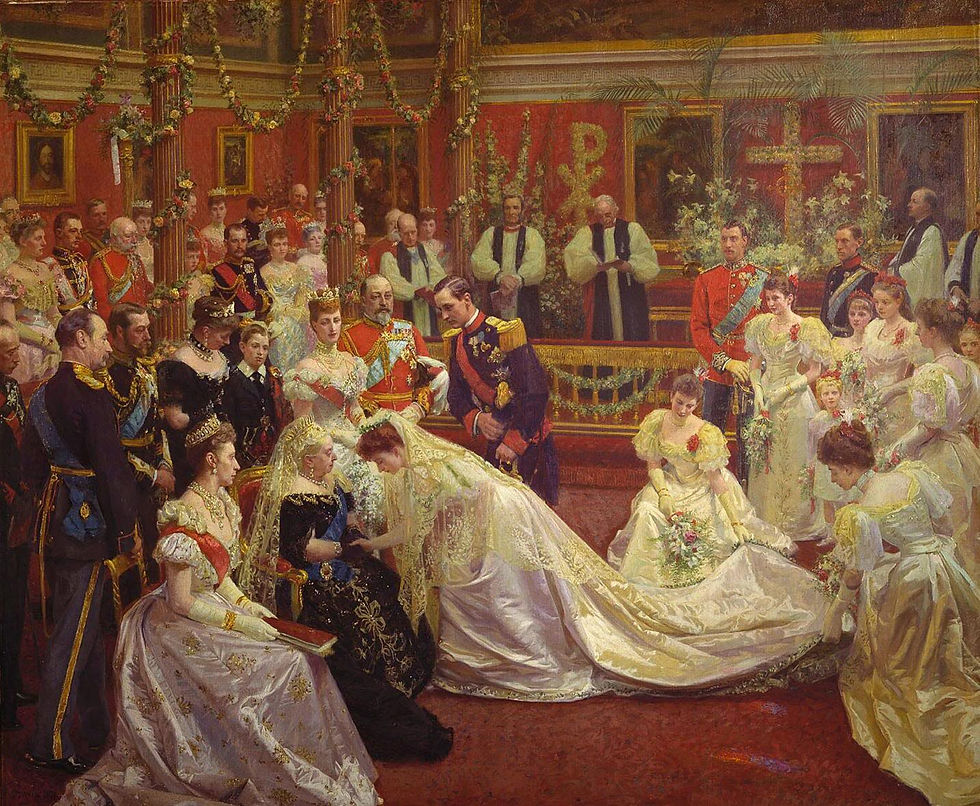


20 November 1947
Princess Elizabeth (Queen Elizabeth II) married Philip Mountbatten (later Prince Philip)
The wedding of Princess Elizabeth & Philip Mountbatten took place at Westminster Abbey in London. The bride was the elder daughter of King George VI & heir presumptive to the British throne. The groom was a former Greek & Danish prince. Philip had been made Duke of Edinburgh, Earl of Merioneth & Baron Greenwich on the morning of the wedding. Elizabeth became the tenth member of the royal family to be married at the Abbey
Princess Elizabeth was attended by eight bridesmaids: The Princess Margaret (her younger sister), Princess Alexandra of Kent (her first cousin), Lady Caroline Montagu-Douglas-Scott (daughter of the Duke of Buccleuch), Lady Mary Cambridge (her second cousin), Lady Elizabeth Lambart (daughter of the Earl of Cavan), Lady Pamela Mountbatten (Philip's first cousin), Margaret Elphinstone (her first cousin), & Diana Bowes-Lyon (her first cousin). Her cousins Prince William of Gloucester & Prince Michael of Kent served as page boys. The bridesmaids wore wreaths "in their hair of miniature white sheaves, Lilies & London Pride, modelled in white satin & silver lame", while the pages wore Royal Stewart tartan kilts.
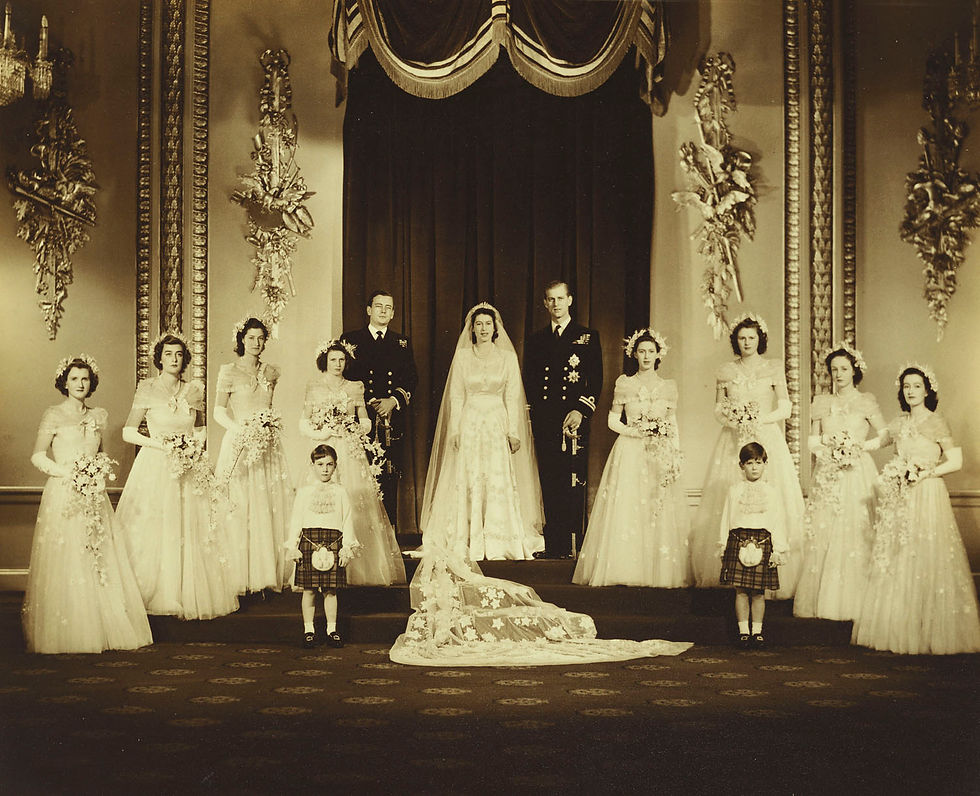
Full length formal group wedding portrait with Princess Elizabeth & Prince Philip standing in the centre flanked by Lord Milford Haven (1919-70) & bridesmaids, as well as by the young Prince William of Gloucester (1941-72) & Prince Michael of Kent (b. 1942). Photograph taken in the Throne Room at Buckingham Palace.
The best man was the Marquess of Milford Haven, the groom's maternal first cousin. The Marquess was a grandson of Prince Louis of Battenberg & Princess Victoria of Hesse and by Rhine; & a great-great-grandson of Queen Victoria.
For her wedding dress, Elizabeth still required ration coupons to buy the material for her gown, designed by Norman Hartnell. The dress was "a duchesse satin bridal gown with motifs of star lilies & orange blossoms." Elizabeth's wedding shoes were made out of satin & were trimmed with silver & seed pearl. Elizabeth did her own makeup for the wedding. Her wedding bouquet was prepared by the florist M. H. Longman & consisted of "white orchids with a sprig of myrtle". The myrtle was taken from "the bush grown from the original myrtle in Queen Victoria's wedding bouquet". The bouquet was returned to the abbey the day after the service to be laid on the tomb of the Unknown Warrior, following a tradition started by Elizabeth's mother at her wedding in 1923.
On the morning of her wedding, as Princess Elizabeth was dressing at Buckingham Palace before leaving for Westminster Abbey, her tiara snapped. The court jeweller, who was standing by in case of emergency, was rushed to his work room by a police escort. Queen Elizabeth reassured her daughter that it would be fixed in time, & it was. Elizabeth's father gave her a pair of pearl necklaces, which had belonged to Queen Anne (1665 – 1714) & Queen Caroline ((1683–1737), as a wedding present. Her diamond & pearl cluster earrings were also family heirlooms, passed down from Princess Mary to Queen Mary's mother the Duchess of Teck.
The royal parties were brought in large carriage processions, the first with the Queen & Princess Margaret and later a procession with Queen Mary. Philip left Kensington Palace with his best man, the Marquess of Milford Haven. Princess Elizabeth arrived at the Abbey with her father, the King, in the Irish State Coach.
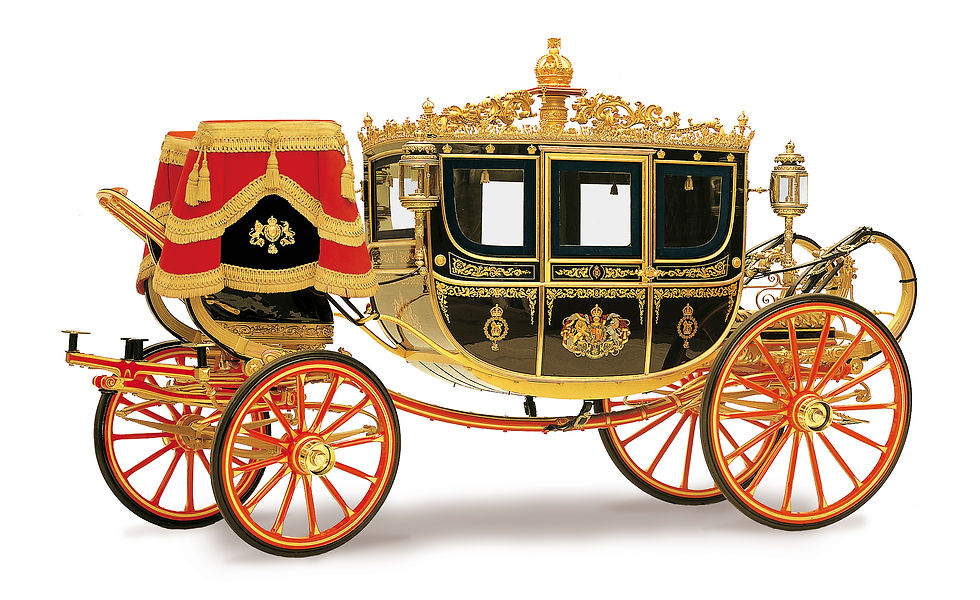

Photograph of King George VI, with the bride, Princess Elizabeth (later HM The Queen) on his arm, at the beginning of the walk up the aisle of Westminster Abbey.
The ceremony was officiated by the Archbishop of Canterbury, Geoffrey Fisher, & the Archbishop of York, Cyril Garbett. The ceremony was recorded & broadcast by BBC Radio to 200 million people around the world.
Like her mother's, Princess Elizabeth's wedding band was made of Welsh gold. The ring was made from a nugget of Welsh gold from the Clogau St David's mine, near Dolgellau; this nugget had been given to the then Lady Elizabeth Bowes-Lyon, & used to make her wedding ring & subsequently the wedding rings of both of her daughters. The same nugget was later used to create the wedding rings of Princess Anne & Lady Diana Spencer.
Before the wedding, Philip renounced his Greek & Danish titles, converted from Greek Orthodoxy to Anglicanism & adopted the style "Lieutenant Philip Mountbatten", taking the surname of his mother's British family. The day before the wedding, King George bestowed the style "Royal Highness" &, on the morning of the wedding, 20 November 1947, he was made the Duke of Edinburgh, Earl of Merioneth, & Baron Greenwich of Greenwich in the County of London. Consequently, being already a Knight of the Garter, between 19 & 20 November 1947 he bore the unusual style His Royal Highness Sir Philip Mountbatten & is so described in the Letters Patent of 20 November 1947. Upon their marriage, Elizabeth took the title of her husband & became Princess Elizabeth, Duchess of Edinburgh.

After the ceremony, Elizabeth & Philip then proceeded to Buckingham Palace, where the couple waved to the crowds from the balcony.
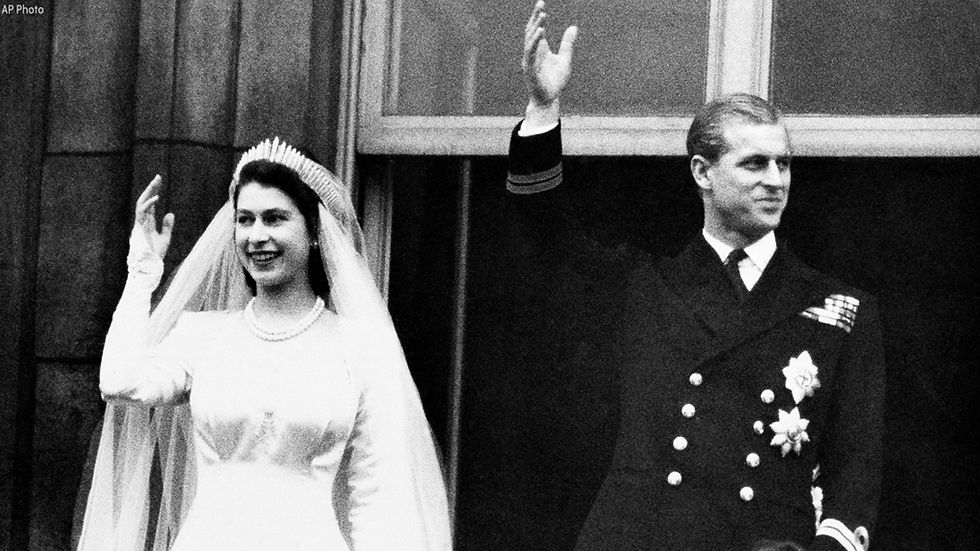
Their wedding breakfast was held in the Ball-Supper Room of the Palace. The menu included Filet de Sole Mountbatten, Perdreau en Casserole, & Bombe Glacee Princess Elizabeth. Music was played by the string band of the Grenadier Guards. The official wedding cake was baked by London bakery McVitie & Price. A fruitcake made of four tiers, it stood nine feet high, & weighed about 500 lbs. It was made with 80 oranges, 660 eggs, & over three gallons of Navy Rum.
The couple received over 2,500 wedding presents from around the world & around 10,000 telegrams of congratulations.
The day after the wedding the wedding bouquet was returned to Westminster Abbey & placed on the Tomb of the Unknown Warrior; this tradition was initiated by the bride's mother, Queen Elizabeth, following her marriage to the bride's father, then the Duke of York. The bouquet was composed of white cattleya, odontoglossum, & cypripedium orchids & a sprig of myrtle from the Osborne Myrtle Bush, which had been planted at Osborne House by Queen Victoria in 1846. The flowers in the bouquet were supplied by the Worshipful Company of Gardeners & were arranged by florist MH Longman.
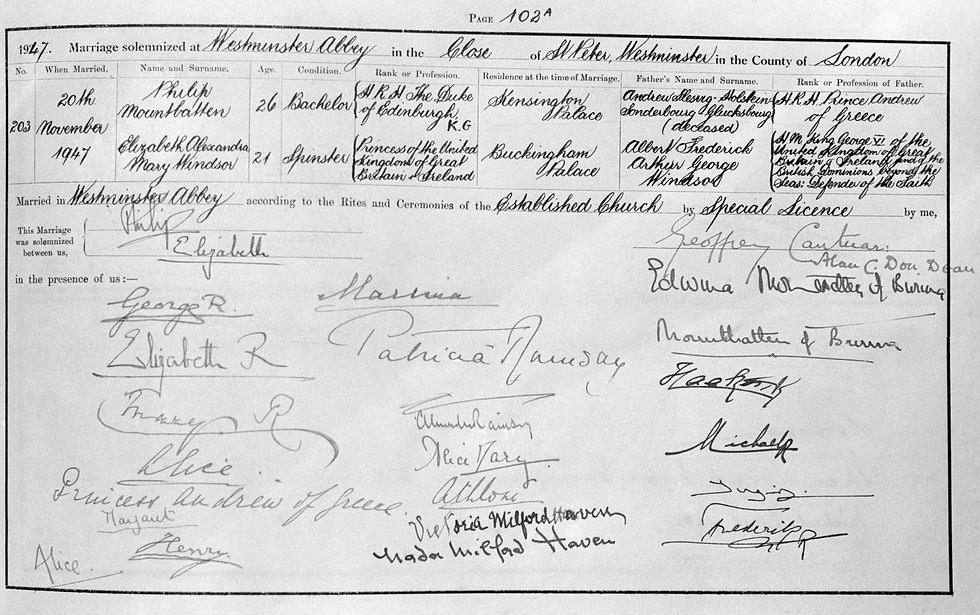
Marriage certificate, signed by Philip, Elizabeth, Elizabeth's father King George VI, Elizabeth's mother Queen Elizabeth, Queen Mary, Princess Andrew of Greece and Denmark, Princess Margaret, Prince Henry, Duke of Gloucester, Princess Alice, Duchess of Gloucester, Princess Marina, Duchess of Kent, Lady Patricia Ramsay, Sir Alexander Ramsay, Princess Alice, Countess of Athlone, the Earl of Athlone, Victoria, Marchioness of Milford Haven, the Marchioness of Milford Haven, the Archbishop of Canterbury, the Dean of Westminster, the Countess Mountbatten and Earl Mountbatten of Burma, the King of Norway, the King of Romania, the Queen & King of Denmark .
21 November

21 November 1673
James, Duke of York (later King James II) married Mary of Modena

Anne Hyde (1637 – 1671), the first wife of James died in 1671. James married Italian Princess Mary of Modena by proxy in a Roman Catholic ceremony on 20 September 1673. On 21 November, Mary arrived in England & Nathaniel Crew, Bishop of Oxford, performed a brief Anglican service that did little more than recognise the marriage by proxy.

Charles died in 1685. Having no legitimate children, Charles was succeeded by his brother James, who reigned in England & Ireland as James II, & in Scotland as James VII.
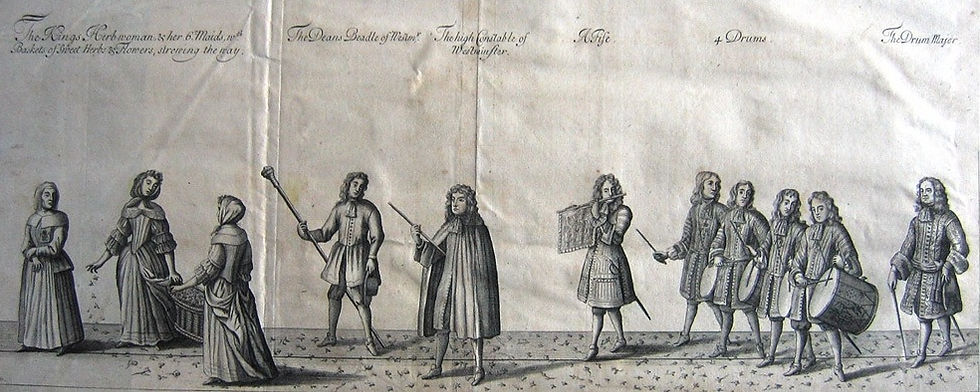
James & Mary's children;
Unnamed child (March or May 1674, miscarriage)
Catherine Laura (1675-1675, died of convulsions.)
Unnamed child (October 1675, stillborn)
Isabel (or Isabella) (1676-1681), styled as "The Lady Isabella, daughter to the Duke of York"
Charles, Duke of Cambridge (1677-1677, died of smallpox)
Elizabeth (c. 1678)
Unnamed child (February 1681, stillborn)
Charlotte Maria (1682-1682 died of convulsions & styled as "The Lady Charlott-Marie, daughter to the Duke of York"
Unnamed child (October 1683, stillborn)
Unnamed child (May 1684, miscarriage)
James, Prince of Wales "the Old Pretender" (1688-1766 married 1719, Clementina Sobieska
Louisa Maria Teresa (1692-1712)

21 November 1840
Victoria, Princess Royal was born at Buckingham Palace, London.
Victoria, Princess Royal (Victoria Adelaide Mary Louisa was German Empress & Queen of Prussia as the wife of German Emperor Frederick III. She was the eldest child of Queen Victoria of the United Kingdom & Prince Albert of Saxe-Coburg and Gotha & was created Princess Royal in 1841. She was the mother of Wilhelm II, German Emperor.

Did You Know? The correspondence between Victoria & her parents has been preserved almost completely: 3,777 letters from Queen Victoria to her eldest daughter, & about 4,000 letters from the empress to her mother are preserved & catalogued. These give a detailed insight into life at the Prussian court between 1858 & 1900.

Prince Frederick William of Prussia with his wife & two older children, Prince William & Princess Charlotte. Portrait by Franz Xaver Winterhalter, 1862.
22 November

22 November 1682
King George I married Sophia Dorothea of Celle
George Louis, The Hereditary Prince of Brunswick-Lüneburg (later George I of Great Britain) married his cousin Sophia Dorothea in Celle.
In 1705 he would inherit the Principality of Lüneburg after the death of his father-in-law & uncle, George William, Duke of Brunswick-Lüneburg, & in 1714 the Kingdom of Great Britain & the Kingdom of Ireland & became King George I of Great Britain through his mother, Duchess Sophia, a granddaughter of James VI and I.
The marriage of George Louis & Sophia Dorothea was an unhappy one. His immediate family, especially his mother Duchess Sophia, hated & despised Sophia Dorothea.

Sophia Dorothea with her two children, by Jacques Vaillant, ca. 1690–1691. Currently displayed at Bomann-Museum, Celle.
The desire for the marriage was almost purely financial, as Duchess Sophia wrote to her niece Elizabeth Charlotte, "One hundred thousand thalers a year is a goodly sum to pocket, without speaking of a pretty wife, who will find a match in my son George Louis, the most pigheaded, stubborn boy who ever lived, who has round his brains such a thick crust that I defy any man or woman ever to discover what is in them. He does not care much for the match itself, but one hundred thousand thalers a year have tempted him as they would have tempted anybody else." These feelings of contempt were shared by George Louis himself, who was oddly formal to his wife. Sophia Dorothea was frequently scolded for her lack of etiquette, & the two had loud & bitter arguments. Things seemed better after the birth of their first two children:
George Augustus, born 1683, later King George II of Great Britain
Sophia Dorothea, born 1686, later wife of King Frederick William I of Prussia, and mother of Frederick the Great
But George Louis acquired a mistress, Melusine von der Schulenburg, & started pointedly neglecting his wife. His parents asked him to be more circumspect with his mistress, fearful that a disruption in the marriage would disrupt the payment of the 100,000 thalers, but he responded by going out of his way to treat his wife brutally.
23 November

23 November 955
Eadred, king of the English died
Eadred (b.923) was King of the English from 946 until his death. He was the son of king Edward the Elder & his third wife Eadgifu of Kent, & a grandson of king Alfred the Great.
He succeeded his elder brother King Edmund I (r. 939-946), who was stabbed to death at Pucklechurch (Gloucestershire), on St Augustine's Day, 26 May 946. The same year, on 16 August, Eadred was consecrated by Archbishop Oda of Canterbury at Kingston upon Thames (Surrey, now Greater London).
The chief achievement of his reign was to bring the Kingdom of Northumbria under total English control, which occurred with the defeat & expulsion of Eric Bloodaxe in 954. Eadred died at the age of 32 having never married, & was succeeded by his 15-year-old nephew, Eadwig.
The Anglo-Saxon Chronicle for the year 946 records that Eadred "reduced all the land of Northumbria to his control; & the Scots granted him oaths that they would do all that he wanted."
Óláf Sihtricson, had been king of Northumbria in the early 940s when he became Edmund's godson & client king, but he was later driven out. He then succeeded his cousin as King of Dublin, but after a heavy defeat in battle in 947, he was once again forced to try his luck elsewhere. Shortly thereafter, Olaf was back in business, having regained the kingdom of York. Olaf was ousted from the kingship a second time by the Northumbrians, this time in favour of Eric son of Harald, according to MS E of the Chronicle.
The other player in the game was Eric Bloodaxe, (previously King of Norway from 930 to 934). He came to Northumbria & appears at some point to have set himself up as king. King Eadred responded harshly to the northern defectors by launching a destructive raid on Northumbria, which notably included burning the Ripon monastery founded by St. Wilfrid. Although his forces sustained heavy losses in the Battle of Castleford, Eadred managed to check his rival by promising the latter's supporters even greater havoc if they did not desert the foreign prince. The Northumbrians appeased the English king & paid compensation. The Historia Regum suggests that the threat of an independent Northumbrian king had come to an end in 952, when earls finally took over the helm.
Towards the end of his life, Eadred suffered from a digestive malady which would prove fatal. 'Author B', the biographer & former apprentice of St Dunstan, described with vivid memory how the king sucked out the juices of his food, chewed on what was left & spat it out. Eadred died at the age of 32 on 23 November (St. Clement's Day), 955, at Frome (Somerset). He was buried in the Old Minster at Winchester. He was succeeded by Edmund's son Eadwig.
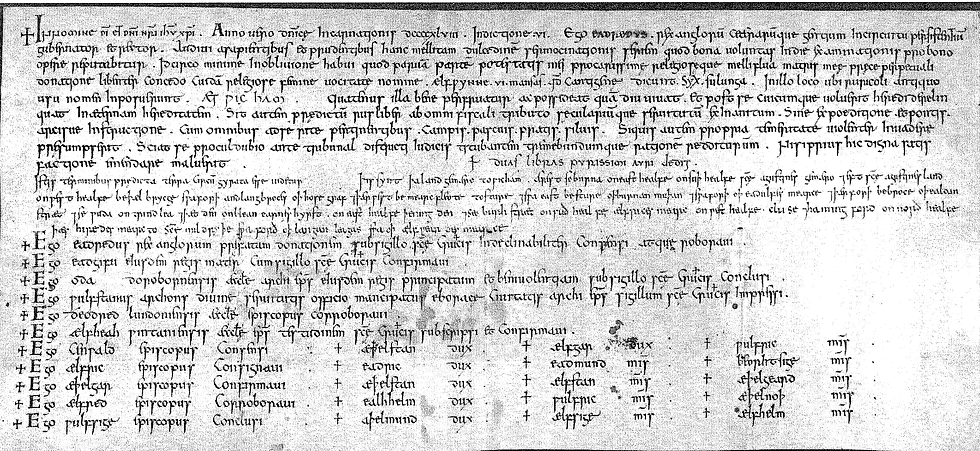

23 November 1503
Margaret of York, Duchess of Burgundy died
Margaret of York (Born 3 May 1446)—also by marriage known as Margaret of Burgundy—was Duchess of Burgundy as the third wife of Charles the Bold & acted as a protector of the Burgundian State after his death. She was a daughter of Richard, 3rd Duke of York, & Cecily Neville, & the sister of two kings of England, Edward IV & Richard III. She was born at Fotheringhay Castle, Northamptonshire, in the Kingdom of England, & she died at Mechelen in the Low Countries.
Contemporary description, Margaret had fine features, & was, at almost 6 feet, very tall, a feature accentuated by her slimness, & her straight & upright bearing. Her eyes were grey, & her mouth was small; her smile allowed her to demonstrate her wry humour, her wit, & her graciousness. In appearance, she was utterly unlike the dark & burly Duke Charles the Bold, who was shorter than her: when they met for the first time, she was forced to bend in order to receive his kiss. But her intelligence was keen, & her will strong; she made a worthy bride for the Duke in nature.
With her husband's family, she got on excellently: she became a mother-figure to her step-daughter, Mary, who shared Margaret's interests in reading, riding, hunting, & falconry; her mother-in-law, Isabella of Portugal, said of Margaret that she was "well pleased with the sight of this lovely lady, & pleased with her manners & virtues". A capable ruler, she proved a masterful Duchess. She bore no male heir to succeed to the Duchy, but she preserved it from ruin; to her actions can be ascribed the survival of the Burgundian state, & the prevention of French dominance in Europe.

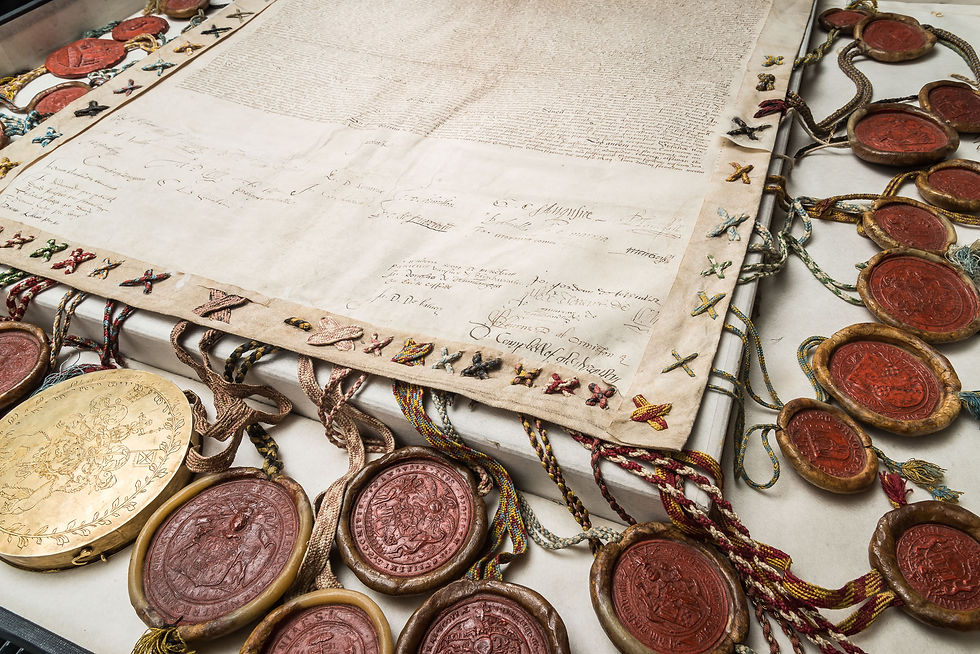
23 November 1589
James VI & I married Anne of Denmark
A suitable marriage was necessary to reinforce his monarchy, & the choice fell on the fourteen-year-old Anne of Denmark, younger daughter of the Protestant Frederick II. Shortly after a proxy marriage in Copenhagen in August 1589, Anne sailed for Scotland but was forced by storms to the coast of Norway. On hearing the crossing had been abandoned, James, in what Willson calls "the one romantic episode of his life", sailed from Leith with a three-hundred-strong retinue to fetch Anne personally.
The couple were married formally at the Bishop's Palace in Oslo on 23 November &, after stays at Elsinore & Copenhagen & a meeting with Tycho Brahe, returned to Scotland on 1 May 1590. By all accounts, James was at first infatuated with Anne, & in the early years of their marriage seems always to have showed her patience & affection. The royal couple produced three children who survived to adulthood: Henry Frederick, Prince of Wales, who died of typhoid fever in 1612, aged 18; Elizabeth, later queen of Bohemia; & Charles, his successor. Anne died before her husband in March 1619.

James VI and I (b.19 June 1566 – d.27 March 1625) was King of Scotland as James VI from 24 July 1567 and King of England & Ireland as James I from the union of the Scottish & English crowns on 24 March 1603 until his death. The kingdoms of Scotland & England were individual sovereign states, with their own parliaments, judiciary, & laws, though both were ruled by James in personal union.

Anne of Denmark (b.12 December 1574 – d.2 March 1619) was Queen consort of Scotland, England, & Ireland as the wife of King James VI & I, Anne was the second daughter of King Frederick II of Denmark.
24 November

24 November 1273
Alphonso, Earl of Chester was born
Alphonso, styled Earl of Chester, was an heir apparent to the English throne who never became king. Alphonso was the ninth child of King Edward I of England & his Castilian wife Eleanor. He was born in Bayonne, Gascony, a duchy claimed by his maternal uncle King Alphonso X of Castile until his parents' marriage in 1254. Edward & Eleanor's friendship with the King of Castile was also confirmed when they named their son in his honour, a "remarkable choice" given the name's rarity in England. Queen Eleanor even persuaded her brother to travel to Gascony & serve as godfather at the young prince's baptism. Alphonso's eldest brother, John, had died in 1271; the death of another older brother, Henry, in 1274, made Alphonso the couple's only son up until the last months of his life. At the age of ten, Alphonso was engaged to Margaret, daughter of Floris V, Count of Holland. An opulent psalter was being prepared for the marriage when he fell ill & died a few months before the wedding was to take place.
The Alphonso Psalter was completed a decade later when his sister Elizabeth married Margaret's brother, John I, Count of Holland, making the pairing of arms again appropriate. Alphonso's death at Windsor occurred shortly after the birth of his younger brother Edward, who became the oldest surviving male heir of Edward I. Alphonso was interred in The Confessor's Chapel at Westminster Abbey, although the exact location is unknown. His heart, however, was buried at the priory of Blackfriars, London (now destroyed).
24 November 1542
Battle of Solway Moss
The Battle of Solway Moss took place on Solway Moss near the River Esk on the English side of the Anglo-Scottish border in November 1542 between English & Scottish forces. King James V of Scotland had refused to break from the Catholic Church, as urged by his uncle King Henry VIII of England, who then launched a major raid into south-west Scotland. The Scottish army that marched against them was poorly led & organised, & many Scots were either captured or drowned in the river.
25 November

25 November 1120
The White Ship sinks in the English Channel near the Normandy coast.
Only one of those aboard survived. Those who drowned included William Adelin, the only legitimate son & heir of King Henry I of England, his half-sister Matilda, & his half-brother Richard. William Adelin's death led to a succession crisis & a period of civil war in England known as the Anarchy.
The White Ship was a newly refitted vessel captained by Thomas FitzStephen, whose father Stephen FitzAirard had been captain of the ship Mora for William the Conqueror when he invaded England in 1066. Thomas offered his ship to Henry I of England to use it to return to England from Barfleur in Normandy. Henry had already made other arrangements but allowed many in his retinue to take the White Ship, including his heir, William Adelin; his illegitimate son Richard of Lincoln; his illegitimate daughter Matilda FitzRoy, Countess of Perche; & many other nobles.
According to chronicler Orderic Vitalis, the crew asked William Adelin for wine & he supplied it to them in great abundance. By the time the ship was ready to leave there were about 300 people on board although some had disembarked before the ship sailed due to the excessive drinking. The ship's captain, Thomas FitzStephen, was ordered by the revellers to overtake the king's ship, which had already sailed. The White Ship was fast, of the best construction & had recently been fitted with new materials, which made the captain & crew confident they could reach England first. But when it set off in the dark, its port side struck a submerged rock called Quillebœuf, & the ship quickly capsized.
William Adelin got into a small boat & could have escaped but turned back to try to rescue his half-sister, Matilda, when he heard her cries for help. His boat was swamped by others trying to save themselves, & William drowned along with them.
It was said that the FitzStephen came to the surface after the sinking & learned that William Adelin had not survived, he chose to let himself drown rather than face the King.


25 November 1487
Elizabeth of York is crowned Queen of England.
[Elizabeth of York]....royally apparelled, in a kirtle of white cloth of gold of damask, and a mantle of the same suit, furred with ermine, fastened before her breast with a great lace, curiously wrought of gold and silk, and rich knobs of gold at the end , tasselled; her fair yellow hair hanging down plain behind her back, with a call of pipes over it, and wearing on her head a circle of gold, richly garnished with precious stones...... - A Queen's coronation, contemporary account by John Leyland.
Elizabeth was queen consort of England from 1486 until her death, as the wife of Henry VII (married on 18 January 1486), she was the first Tudor queen. She was the daughter of Edward IV, sister of Edward V & niece of Richard III, & she married the king following Henry's victory at the Battle of Bosworth which started the last phase of the Wars of the Roses. She was the mother of King Henry VIII.
Therefore, she was the daughter, sister, niece, wife, & mother of successive Kings of England. Despite being a political arrangement at first, the marriage proved successful & both partners appear to have grown to love each other.
They had eight children,
Arthur, Prince of Wales (20 September 1486 – 2 April 1502)
Margaret, Queen consort of Scotland (28 November 1489 – 18 October 1541)
Henry VIII of England (28 June 1491 – 28 January 1547)
Elizabeth Tudor (2 July 1492 – 14 September 1495)
Mary, Queen consort of France (18 March 1496 – 25 June 1533)
Edward Tudor (c.1498 - d. 1499)
Edmund, Duke of Somerset (21 February 1499 – 19 June 1500)
Katherine Tudor (2 February 1503 – 10 February 1503)

25 November 1609
Henrietta Maria of France was born
Henrietta Maria of France was queen consort of England, Scotland, & Ireland as the wife of King Charles I. She was mother of his two immediate successors, Charles II & James II. She was the fourth daughter of King Henry IV of France & his second wife Marie de' Medici.

She was born at the Palais du Louvre on 25 November 1609. As daughter of the Bourbon king of France, she was a Fille de France & a member of the House of Bourbon. She was the youngest sister of the future King Louis XIII of France. Her father was assassinated on 14 May 1610, in Paris, before she was a year old.
Henrietta Maria & Charles I of England were married on 13 June 1625, during a brief period in which England's pro-Spanish policy was replaced by a pro-French policy. Her Catholic religion made her unpopular in England, & also prohibited her from being crowned in an Anglican service; therefore she never had a coronation. She began to immerse herself in national affairs as civil war loomed on the horizon & was compelled to seek refuge in France in 1644, following the birth of her youngest daughter, Henrietta, during the height of the First English Civil War.

Henrietta Maria & King Charles I, with Charles, Prince of Wales, & Princess Mary, painted by Anthony van Dyck, 1633.
The execution of King Charles in 1649 left her impoverished. She settled in Paris, & then returned to England after the Restoration of her eldest son, Charles (Charles II), to the throne. In 1665, she moved back to Paris, where she died four years later on 10 September 1669. The North American Province of Maryland was named in her honour, and the name was carried over into the current US state of Maryland.

25 November 1638
Catherine of Braganza was born
Catherine of Braganza was Queen of England, Scotland & Ireland from 1662 to 1685, as the wife of King Charles II.
Catherine was born into the House of Braganza in 1705, the most senior noble house of Portugal, which became Portugal's royal house after Catherine's father, John, 8th Duke of Braganza, was proclaimed King John IV after deposing the House of Habsburg in 1640.
Owing to her devotion to the Roman Catholic beliefs in which she had been raised, Catherine was an unpopular consort for Charles II. She was a special object of attack by the inventors of the Popish Plot. In 1678 the murder of Sir Edmund Berry Godfrey was ascribed to her servants, & Titus Oates accused her of an intention to poison the king. These charges, the absurdity of which were soon shown by cross-examination, nevertheless placed the queen for some time in great danger. On 28 November Oates accused her of high treason, & the Commons passed an order for her removal & that of all Roman Catholics from Whitehall. A series of fresh depositions were made against her, & in June 1679 it was decided that she must stand trial; but she was protected by the king, who in this instance showed unusual chivalry, for which he earned her gratitude.
Catherine suffered three miscarriages, & as a result she did not produce any heirs. She & Charles are credited with introducing the custom of drinking tea to the British court, which was common among the Portuguese nobility. She died at the Bemposta Palace in Lisbon on 31 December 1705 aged 67 & was buried at the Monastery of São Vicente de Fora Lisbon.
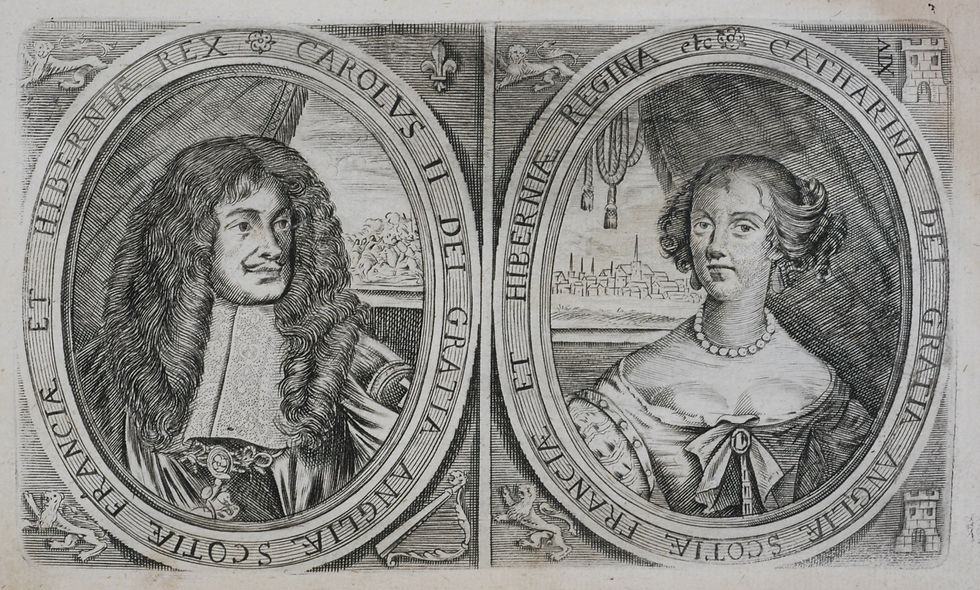
26 November

26 November 1869
Maud of Wales, Queen of Norway was born
Maud was born at Marlborough House, London. She was the third daughter and fifth child of Albert Edward, Prince of Wales (later King Edward VII), the eldest son of Queen Victoria, and Princess Alexandra of Denmark. She was christened "Maud Charlotte Mary Victoria" at Marlborough House by John Jackson, Bishop of London, on 24 December 1869.

Maud Charlotte Mary Victoria of Wales was Queen of Norway as spouse of King Haakon VII. Maud of Wales was the first queen of Norway since 1380 who was not also queen of Denmark or Sweden.
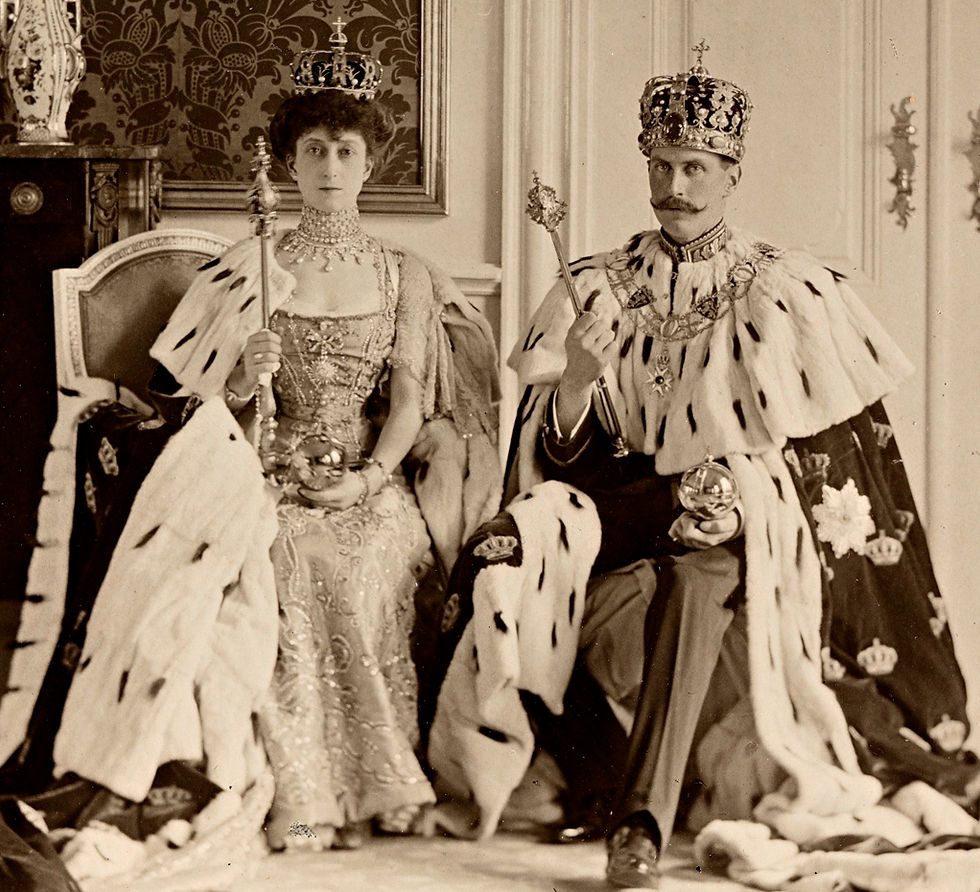
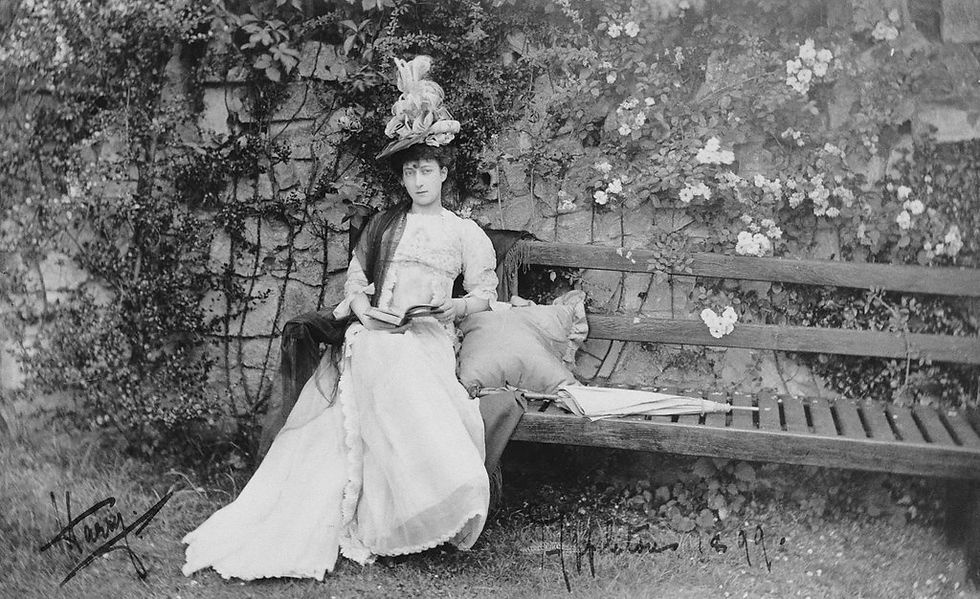
27 November

27 November 1833
Princess Mary Adelaide of Cambridge was born (d. 1897)
Princess Mary Adelaide of Cambridge, later Duchess of Teck, was a member of the British royal family. She was one of the first royals to patronise a wide range of charities.
Mary Adelaide was the daughter of Prince Adolphus, Duke of Cambridge, & Princess Augusta of Hesse-Kassel. Her father was the seventh son of King George III & Queen Charlotte. Mary Adelaide married Francis, Duke of Teck, with whom she had four children. The Duke & Duchess of Teck's daughter, "May", was the wife of King George V & became known as Queen Mary. Through her daughter, Mary Adelaide was the grandmother of the British kings Edward VIII & George VI.
28 November

28 November 1290
Eleanor of Castile died (b. 1241)
Eleanor was the first queen consort of king Edward I of England. Eleanor was born in Burgos, daughter of Ferdinand III of Castile & Joan, Countess of Ponthieu. She married Edward, son of Henry III of England on 1 November 1254 in the Abbey of Santa María la Real de Las Huelgas in Castile. In 1270 Edward & Eleanor left to join his uncle Louis IX of France on the Eighth Crusade. They left Acre in September 1272, & in Sicily that December, they learned of Henry III's death (on 16 November 1272). Edward & Eleanor returned to England & were crowned together on 19 August 1274. Eleanor & Edward were devoted to each other. Edward is among the few medieval English kings not known to have conducted extramarital affairs or fathered children out of wedlock. The couple were rarely apart; she accompanied him on military campaigns in Wales, famously giving birth to their son Edward on 25 April 1284 at Caernarfon Castle, either in a temporary dwelling erected for her amid the construction works, or in the partially constructed Eagle Tower.
Shortly after the birth of her fifteenth child (she had at least sixteen known pregnancies), Beatrice, Eleanor's health began to deteriorate. In 1287, while she was in Gascony she suffered from a double quartan fever, which was possibly a strain of malaria. In the autumn of 1290, The King & Queen travelled towards Lincoln, Eleanor was unwell with a feverish illness, probably a recurrence of the quartan fever of 1287. Eleanor's condition worsened as they reached the village of Harby, in Nottinghamshire, & she died there, with Edward at her bedside on the evening of the 28th November 1290, aged 49.
The normally thick-skinned Edward I was deeply affected by her death. In a letter of January 1291, seeking prayers for the soul of his late wife, he wrote "whom living we dearly cherished, & whom dead we cannot cease to love." In her memory, he ordered the construction of twelve elaborate stone crosses, known as the Eleanor Crosses, tall, pointed, highly ornamented monuments (of which three survive) between 1291 & 1294, marking the route of her funeral procession between Lincoln & London.
From St Catherine's Priory in the south of Lincoln, the cortege took 12 days to reach London & between 1291 & 1294 for each place where the procession rested overnight an Eleanor's Cross was erected. The stopping places were at Grantham, Stamford, Geddington, the Delapre Convent at Hardingstone, Northampton, Stony Stratford, Dunstable, Waltham Abbey, Cheapside & Charing Cross (deriving from chere reine cross- dear queen cross). The only remaining piece of the St Catherine's cross left in Lincoln is housed in Lincoln Castle but there are three crosses remaining at Geddigton, Hardingstone & Waltham, replicas exist at other places such as Banbury).

After embalming, which in the thirteenth century involved evisceration, Eleanor's viscera were buried in Lincoln Cathedral & Edward placed a duplicate of the Westminster tomb there. Eleanor's heart was taken with her body to London & was buried Blackfriars Priory. Eleanor's funeral took place in Westminster Abbey on 17th December 1290. Her tomb consisting of a marble chest with carved mouldings & shields, of the arms of England, Castile, & Ponthieu. The chest is surmounted by gilt-bronze effigy by William Torel.

Posthumous portrait of Margaret Tudor (1489-1541), Queen consort of Scotland. Presumably copied from an earlier portrait.
28 November 1489
Margaret Tudor, Queen of James IV of Scotland, daughter of Henry VII of England was born (d. 1541)
Margaret Tudor also known as Margaret, Queen of Scots, was born at Westminster Palace on 28 November 1489. She was the elder of the two surviving daughters of Henry VII of England & Elizabeth of York, & the elder sister of Henry VIII.
In 1503, she married James IV, King of Scots. James died in 1513, and their son became King James V. She married secondly Archibald Douglas, 6th Earl of Angus. Through her first & second marriages, respectively, Margaret was the grandmother of both Mary, Queen of Scots, & Mary's second husband, Lord Darnley.
Margaret's marriage to James IV foreshadowed the Union of the Crowns their great-grandson, King James VI of Scotland, the child of Mary & Darnley, also became the king of England & Ireland on the death of Margaret's fraternal niece, Elizabeth I of England in 1603.
29 November

29 November 1338
Lionel of Antwerp, Duke of Clarence was born (d.1368)
Lionel of Antwerp, Duke of Clarence, was the third son, but the second son to survive infancy, of the English king Edward III & Philippa of Hainault. He was named after his birthplace, at Antwerp in the Duchy of Brabant. Lionel was a grandson of William I, Count of Hainaut. He grew to be nearly seven feet (210 cm) in height & had an athletic build.
30 November

30 November 1016
Edmund Ironside, king of the English died
He was King of the English from 23 April-30 November 1016. He was the son of King Æthelred the Unready. Edmund's reign was marred by a war he had inherited from his father; his cognomen "Ironside" was given to him "because of his valour" in resisting the Danish invasion.
Edmund was not expected to be King of England; however, by June 1014 two elder brothers had died, making him heir apparent. England was conquered by Sweyn Forkbeard at the end of 1014, but he died shortly thereafter, paving the way for Æthelred to return to the throne, which he did, but not without opposition. Sweyn's son, Cnut, was defeated & returned to Denmark, where he assembled an invasion force to re-conquer England. It would not arrive for another year.
After regaining the throne, the royal family set about strengthening its hold on the country with the assistance of Eadric Streona (Edmund's brother-in-law). People who had sided with the Danes in 1014 were punished, & some were killed. Cnut returned to England in August 1015. Over the next few months, Cnut pillaged most of England. Edmund joined Æthelred to defend London, but in 1016 Edmund unofficially named himself the Earl of the East Midlands & raised a revolt against his father. Without the king's permission he took Ealdgyth from the monastery & married her; it would have been a politically advantageous marriage, since she was a member of one of the strongest families in the Midlands.
Æthelred died on 23 April 1016, making Edmund king. It was not until the summer of 1016 that any serious fighting was done, Edmund fought five battles against the Danes, ending in his defeat on 18 October at the Battle of Assandun, after which they agreed to divide the kingdom, Edmund taking Wessex & Cnut the rest of the country. Edmund died shortly afterwards on 30 November, leaving two sons, Edward & Edmund; however, Cnut became the king of all England, & exiled the remaining members of Edmund's family.
Thank you for reading.





Kaiser OTC benefits provide members with discounts on over-the-counter medications, vitamins, and health essentials, promoting better health management and cost-effective wellness solutions.
Obituaries near me help you find recent death notices, providing information about funeral services, memorials, and tributes for loved ones in your area.
is traveluro legit? Many users have had mixed experiences with the platform, so it's important to read reviews and verify deals before booking.